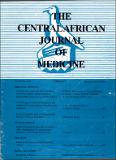| dc.contributor.author | Lau, C. | |
| dc.contributor.author | Muula, A.S. | |
| dc.contributor.author | Kalanda, R. | |
| dc.contributor.author | Horwitz, G. | |
| dc.contributor.author | Misiri, H. | |
| dc.coverage.spatial | Malawi. | en_GB |
| dc.date.accessioned | 2014-10-30T11:12:18Z | |
| dc.date.available | 2014-10-30T11:12:18Z | |
| dc.date.issued | 2004-09 | |
| dc.identifier.citation | Lau, C. et. al. (2004) Test offering, not additional information, may increase HIV testing uptake in a knowledgeable population, CAJM vol. 50, no. 9. Harare, Avondale: CAJM. | en_GB |
| dc.identifier.issn | 0008-9176 | |
| dc.identifier.uri | https://opendocs.ids.ac.uk/opendocs/handle/20.500.12413/4919 | |
| dc.description | A CAJM journal article. | en_GB |
| dc.description.abstract | Objectives: To evaluate patient HIV knowledge and testing experience and assess the effect of an HIV informational handout on HIV testing propensity.
Design: Cross sectional, descriptive techniques were employed to assess demographics, HIV knowledge and HIV testing experience. A randomized controlled trial was performed to determine if an HIV/AIDS information sheet influenced testing propensity.
Setting: Blantyre Adventist Hospital Outpatient Clinic.
Subjects: Non-emergency patients over 18 years old attending during consulting hours.
Interventions: All subjects answered a questionnaire. For the randomized controlled trial component, half received an HIV information handout.
Main Outcome Measures: Proportions were calculated to evaluate testing experience. Logistic regression was used to assess impact of written information and demographics on HIV testing propensity.
Results: 490 participants were recruited, of whom 57% had never been tested for HIV. Of the untested, 88% had never been offered an HIV test. Of those that had never been offered a test, 46% desired one. The sample was highly knowledgeable about HIV. Reading an information sheet had no impact on HIV knowledge (p=0.736 to 0.788) or desire for testing (p=0.387). However, age (OR=0.97,95%CI (0.95,0.99)) and gender (OR=1.85, 95%CI (1.06, 3.23)) significantly correlated with testing propensity.
Conclusions: A large percentage of patients who have never been offered HIV testing desire testing. More frequent HIV test offering by clinicians could improve testing rates. Clinician education programmes should be developed to increase test offering. Furthermore, written health information in a setting of high HIV/AIDS knowledge may not change behaviour. Alternative methods should be employed to encourage HIV testing uptake. | en_GB |
| dc.language.iso | en | en_GB |
| dc.publisher | Central African Journal of Medicine (CAJM), University of Zimbabwe | en_GB |
| dc.rights.uri | http://creativecommons.org/licenses/by-nc-nd/3.0/ | en_GB |
| dc.subject | HIV/AIDS | en_GB |
| dc.title | Test offering, not additional information, may increase HIV testing uptake in a knowledgeable population | en_GB |
| dc.type | Article | en_GB |
| dc.rights.holder | University of Zimbabwe | en_GB |


